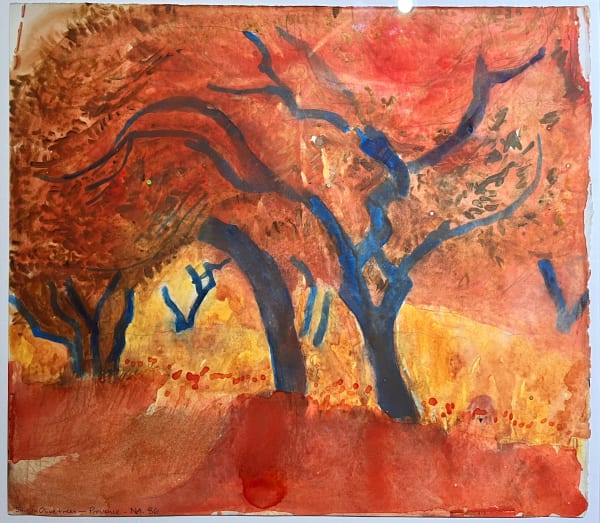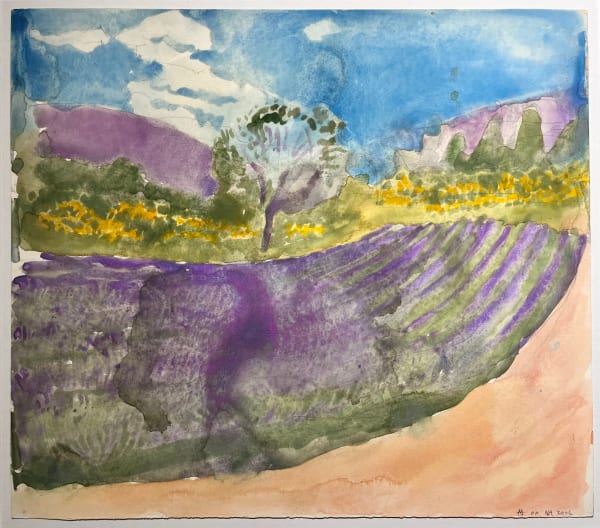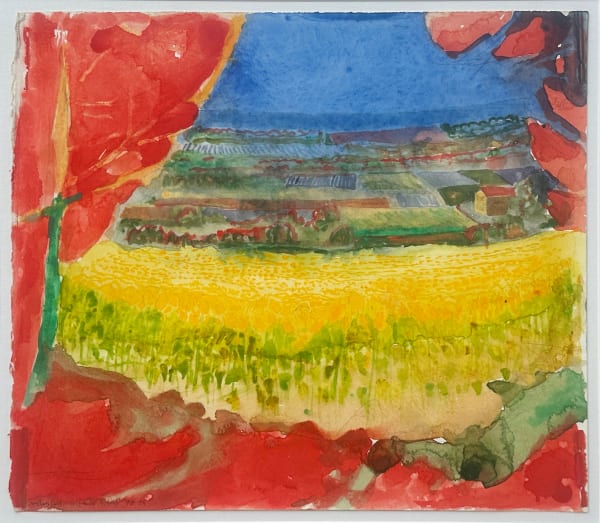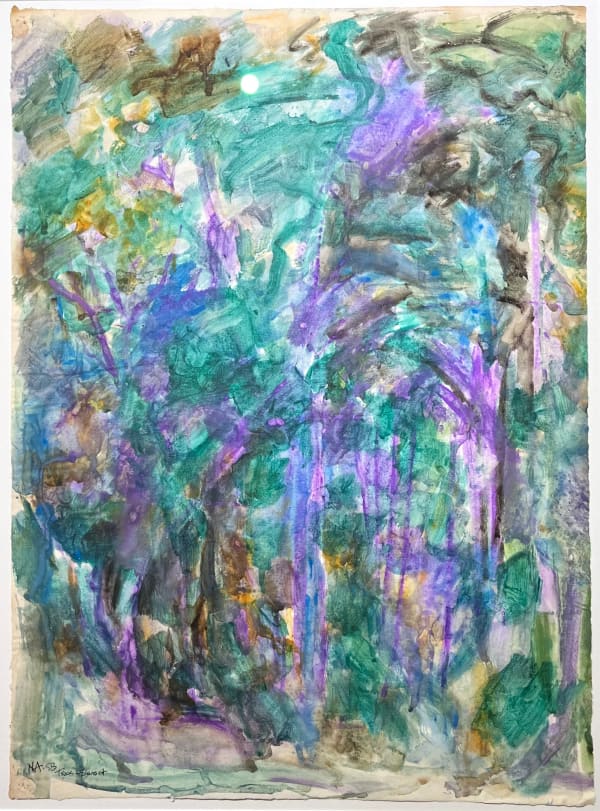Original Artworks by Norman Adams RA
-
Norman Adams RA (1927 - 2005 ), his work is part of rich tradition of romantic visionary painting in Britain, drawing close parallels to the works of earlier English painters like Blake and Turner. He admired Blake's poetic intensity and integrity, despite recognising Blake's lack of feeling for paint, and sought to fuse these qualities with a deep connection to nature. Settling in the Yorkshire Dales , the purity and raw beauty of these landscapes, as well as the Outer Hebrides and Provence, profoundly influenced his work.
Norman Adams' legacy is that of a visionary painter whose works continue to evoke a deep spiritual resonance, bridging the gap between the sacred and the natural world. -
Works
-
 Olive Trees, Provence I, 1997£ 1,300.00
Olive Trees, Provence I, 1997£ 1,300.00 -
 Butterfly, 1991Sold
Butterfly, 1991Sold -
 Fields and Olive Trees, 1989£ 1,300.00
Fields and Olive Trees, 1989£ 1,300.00 -
 Olive Trees, Provence II, 1989Sold
Olive Trees, Provence II, 1989Sold -
 Sun in Olive Trees - Provence , 1986Sold
Sun in Olive Trees - Provence , 1986Sold -
 Lavender Field and Distant Sunflowers, 1985£ 1,300.00
Lavender Field and Distant Sunflowers, 1985£ 1,300.00 -
 Sunflower Field, S. France, St Felix, 1984£ 1,300.00
Sunflower Field, S. France, St Felix, 1984£ 1,300.00 -
 Olive Trees Near St. Remy de Provence , 1981£ 1,300.00
Olive Trees Near St. Remy de Provence , 1981£ 1,300.00 -
 Sunbeams Through Storm Clouds, 1958Sold
Sunbeams Through Storm Clouds, 1958Sold -
 Trees Sunset, 1958£ 2,000.00
Trees Sunset, 1958£ 2,000.00 -
 Trees at Sherwood Brow, 1957Sold
Trees at Sherwood Brow, 1957Sold -
 Large Cloud over Ingleborough - Evening , 1956£ 1,400.00
Large Cloud over Ingleborough - Evening , 1956£ 1,400.00 -
 Thunderclouds Ribblesdale, 1956Sold
Thunderclouds Ribblesdale, 1956Sold -
 Trees Douk Ghyll , 1956Sold
Trees Douk Ghyll , 1956Sold -
 Trees in the Wind, 1956Sold
Trees in the Wind, 1956Sold
-
-
Biography
Norman Adams' legacy is that of a visionary painter whose works continue to evoke a deep spiritual resonance, bridging the gap between the sacred and the natural world.
Born in London, Norman Adams showed early artistic promise and began his studies at Harrow School of Art at the age of 13. He later attended the Royal College of Art following a brief period of military service, which was cut short when he registered as a conscientious objector. His experience in prison during this time convinced him that art must carry a message, something he later described as "religious in the broadest sense."
Adams' work is part of a rich tradition of romantic visionary painting in Britain, drawing close parallels to the works of earlier English painters like Blake and Turner. He admired Blake's poetic intensity and integrity, despite recognizing Blake's lack of feeling for paint, and sought to fuse these qualities with a deep connection to nature.
Throughout his career, Adams was influenced by the German expressionists, such as Kirchner and Nolde, and the Belgian artists Permeke and Ensor. Van Gogh, however, became a significant influence later in his life, particularly for his intensity of vision.
After teaching at St Albans art school and working on ballet decor and costumes for Sadler's Wells and Covent Garden, Adams moved to the countryside, where he felt a deeper connection to the elemental landscape. He and his wife Anna eventually settled in Horton-in-Ribblesdale in the Yorkshire Dales, where he built a studio that overlooked the Pennine Way. The purity and raw beauty of these landscapes, as well as the Outer Hebrides and Provence, profoundly influenced his work.
Adams' paintings are a blend of poetic and personal vision with acute observation. His early watercolors, depicting atmospheric landscapes, culminated in larger oil paintings exhibited in 1966. A visit to Italy that year, where he encountered Giotto's frescoes, led to a series of paintings inspired by religion, mythology, and mysticism. These works, while admired, were often seen as esoteric due to their complex symbolism.
In the 1970s, Adams created murals and ceramic reliefs for various churches, including the Stations of the Cross for St Mary's Roman Catholic Church in Manchester. These works achieved a unity between traditional religious imagery and his earlier pantheistic vision of nature.
Adams was a prolific artist, producing numerous oil paintings and watercolors each year, with his works being widely exhibited. He held senior teaching positions at Manchester and Newcastle before becoming the keeper of the Royal Academy Schools in 1986 and later, the professor of painting from 1995 to 2000.
Norman Adams' legacy is that of a visionary painter whose works continue to evoke a deep spiritual resonance, bridging the gap between the sacred and the natural world.
-
FAQs
Adams was elected a Royal Academician in 1972 and later served as Keeper of the Royal Academy Schools. Throughout his career, he remained committed to exploring the emotional power of painting, combining an instinctive response to the landscape with a strong personal vision. Throughout his career he was influenced by the German Expressionist, such as Kirchner and Nolde, and Belgian artist Permeke and Ensor. Van Gogh, however, became a significant influence later in his life, particularly for his intensity of vision.
Norman Adams paintings are a blend of poetic and personal vision with acute observation. His early watercolours, depicting atmospheric landscapes, culinated in larger oil paintings exhibited in 1966. A visit to Italy that year, where he encountered Giotto's frescoes, led to a series of paintings inspired by religion, mythology and mysticism. These works while admired, were often seen as esoteric due to their complex symbolism.
Norman Adams studied at Harrow School of Art before continuing his training at the Royal College of Art in London. He left the college in 1951, he was beginning to for the view that "art was not just a matter of painting objects, but getting beyond objects". He then taught at St Albans art school and designed decor and costumes for ballets at Sadler's Wells and Covent Garden. He left London whenever possible to paint in Yorkshire and Ireland. He began to feel painters living in cities spent too much time looking over each other's shoulders, and eventually " lose their heritage and are spiritually emasculated".
Norman Adams found inspiration in both the natural world and religious themes. The rugged landscapes of the British countryside, especially the Yorkshire Dales and the Scottish Highlands, played a major role in his work. His religious paintings often explored themes of faith, suffering, and hope, using symbolic imagery and powerful colour to communicate emotion. Adams approached both landscape and religious subjects with a deep sense of wonder, treating them as a means of exploring the human spirit and our relationship to the world around us.
Norman Adams was elected a Royal Academician in 1972, recognising his contribution to British art. In 1986, he was appointed Keeper of the Royal Academy Schools, where he was responsible for the artistic training of new generations of artists. Adams took his role as a mentor seriously, encouraging students to find their own voices while developing strong technical skills. His leadership was marked by a belief in the emotional and imaginative possibilities of painting. He remained connected to the Royal Academy until his death in 2005, leaving a lasting influence.
Norman Adams was highly skilled in the use of watercolour, a medium he often used to create some of his most powerful and emotional works. Unlike traditional watercolour techniques that emphasise delicate washes, Adams used bold, saturated colour and vigorous brushwork to bring a sense of energy and intensity to his paintings. His watercolours captured shifting light, dramatic weather, and deep emotional resonance, often blurring the line between landscape and inner experience. The fluidity of watercolour suited his expressive style, allowing him to respond quickly and instinctively to his subjects.
















